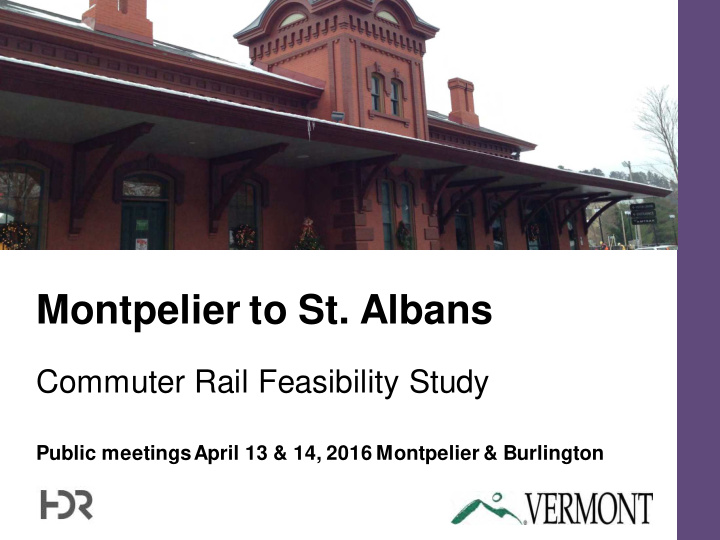



Montpelier to St. Albans Commuter Rail Feasibility Study Public meetings April 13 & 14, 2016 Montpelier & Burlington
AGENDA NORTH STATION What’s this Project? What Conditions allow for a Commuter Rail? Who Are We? What’s Next? Questions
STUDY ORIGINS NORTH STATION Vermont State Legislature Directive: H.488, 2015, Section 12 MONTPELIER TO ST. ALBANS COMMUTER RAIL SERVICE; FEASIBILITY STUDY Determine the feasibility of implementing a commuter rail system within the corridor; Estimate the time horizon to plan for and design the service; Estimate ridership potential Estimate costs for operations and capital acquisition; and Identify any other general operational, capital, legal, and administrative requirements.
STUDY MISSION Determine the Feasibility of NORTH STATION Implementing a Commuter Rail System within the Corridor Evaluate the Financial and Operational Logistics for Operating Commuter Rail in the Project Corridor Develop a Framework for Implementing Commuter Rail Service and Time/Ridership Horizon for Service
THE TEAM Vermont Agency of Transportation NORTH STATION Policy and Planning Unit HDR Engineering New England Office Rail Group Stakeholders Transit Providers, such as Green Mountain Transit Regional Planning Commissions Rail Roads Vermont Rail Council State Legislature
STUDY CONSIDERATIONS Existing Rail Corridors NORTH STATION This Study will be Conceptual Focus on Key Attributes Rather than Detailed Program Development Connections from Essex to Burlington Station Location in Montpelier
STUDY SCOPE Existing Conditions Analysis NORTH STATION Description of Commuter Rail System Attributes Commuter Rail Operations Analysis Transit Demand Cost Estimate and Funding Implementation Considerations Stakeholder & Public Meetings Findings and Final Report (January 2017)
STUDY AREA NORTH STATION
STUDY AREA Montpelier to St. Albans Railroad Corridors Commuter Rail Feasibility Study NORTH STATION New England Central Railroad Mainline Washington County Railroad Winooski Branch Railroad Stations St. Albans Station Essex Junction Station Burlington Union Station Waterbury Station Montpelier-area Station
STUDY AREA CONTEXT Active Vermont Passenger NORTH STATI ON Rail Vermonter Service Ethan Allen Service Existing Intercity and Commuter Bus Green Mountain Transit Link Bus Private Services, including Megabus, and Greyhound Study Region
Commuter Rail Overview
COMMUTER RAIL OVERVIEW Provide Access: Connect Population Centers to Employment Hubs – Bring the Commuter to the City, Not Act as a Distributor Alternative Transportation Mode in areas with Heavy Road Congestion and limited Parking Provides Faster Travel than City Transit (Bus, Subway, Light Rail) but Slower than Intercity Service (Amtrak) Stations Are Spaced a Minimum of 2-Miles Apart Operating Characteristics: Share Right-of-Way with Freight and Intercity Trains Systems Operate at Speeds below 79 MPH Equipment and Infrastructure Must Meet Federal Railroad Administration and Federal Transit Administration Standards
PASSENGER EXPERIENCE Services Focused on Peak Arrival and Departure Times AM Peak: 6:00 -10:00 PM Peak: 3:30 - 7:00 More Reliable Travel Times due to Absence of Road Congestion and Less Weather Related Impediments Fares Typically Depend on Distance Traveled Most Stations Feature Parking and Covered/Enclosed Waiting Areas Connecting Services to Provide Distribution in Central Area
Where is Commuter Rail? Source: The Transport Politic; http://www.thetransportpolitic.com/existing- systems/existing-commuter-rail-systems/
Where is Commuter Rail in the United States? System Name Metro Area System Length Average Weekday (Miles) Ridership Metra Chicago 487.7 290,500 New Jersey Transit New York City and Philadelphia 398.2 295,173 Metrolink Los Angeles 388 41,200 New York City Metro-North Railroad Northern Suburbs and CT 385 298,900 MBTA Commuter Rail Boston 368 130,600 New York City Long Island Rail Road Long Island 321 337,800 SEPTA Regional Rail Philadelphia 280 134,600 MARC Train Baltimore – Washington 187 35,200 Sacramento Capitol Corridor San Francisco Bay Area 168 4,500 New Mexico Rail Runner Express Albuquerque – Santa Fe 97 3,400 South Shore Line Chicago 90 11,800 Virginia Railway Express Washington 90 17,900 Utah Transit Authority (the FrontRunner) Salt Lake City 88 16,800
Where is Commuter Rail in the United States? System Name Metro Area System Length Average Weekday (Miles) Ridership Altamont Corridor Express (ACE) San Jose – Stockton 86 4,600 Sounder Seattle – Tacoma 80 13,700 Caltrain San Francisco – San Jose 77 56,700 Tri-Rail Miami – South Florida 70.9 14,400 Shore Line East New Haven – New London 59 2,200 Coaster San Diego – Oceanside 41 4,900 Northstar Commuter Rail Minneapolis – St. Paul 40 2,500 Trinity Railway Express Dallas – Fort Worth 34 8,200 Capital MetroRail Austin 32 2,800 Music City Star Nashville 32 1,200 SunRail Orlando 31.7 3,200 A-train Dallas – Fort Worth 21 1,900 WES Commuter Rail Portland 15 1,800
CASE STUDY: MUSIC CITY STAR Metro Area : Nashville, TN Population: 650,000, greater area: 1.75 million Daily Ridership : 1,225 Length : 6 Stations, 32 miles Service : Monday-Friday with 5 Daily Roundtrips (6 on Fridays) Annual Financial Support : $13 Million
NEXT STEPS June Study Advisory Committee Meeting September Study Advisory Committee Meeting Public Information Session November Study Advisory Committee Meeting Rail Council Meeting December Final Report Completed January Submission to the House and Senate Committees on Transportation
CONTACT INFORMATION Scott Bascom Vermont Agency of Transportation Tel: (802) 828-5748 E-mail: Scott.Bascom@vermont.gov Ron O’Blenis HDR Engineering Tel: (617) 519-4091 E-mail: Ron.OBlenis@hdrinc.com
Recommend
More recommend